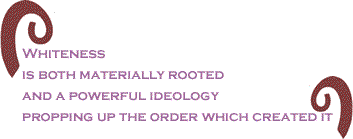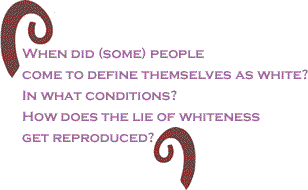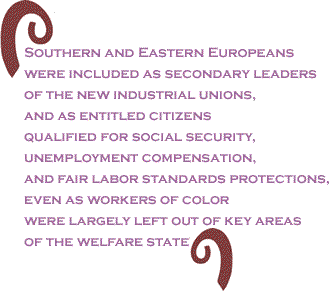
|
|||||||||||||||||||||
 |
|
|
This interview originally appeared in Mrzine, the online site of the Monthly Review. David Roediger, professor of history at the University of Illinois at Urbana-Champaign, and a scholar of critical whiteness studies, delivered a talk titled "The Dilemmas of Popular Front Antiracism: Looking at The House I Live In" on November 17 at the Marxist School of Sacramento. After screening this WW II film that stars Frank Sinatra, Roediger discussed what it tells us about the limits of anti-racisms that imagine we can subordinate justice to unity. He connected the film to the themes of his recent book, Working toward Whiteness: How America's Immigrants Became White. Roediger's research interests include race and class in the United States, and the history of U.S. radicalism. Among his other books are Our Own Time: A History of American Labor and The Working Day (with Philip S. Foner), The Wages of Whiteness: Race and the Making of the American Working Class, Towards the Abolition of Whiteness, Colored White: Transcending the Racial Past, and History Against Misery (Charles H. Kerr). Seth: Your area of interest is critical whiteness studies. Please explain the term for those unfamiliar with it. David: The areas in which I teach are working-class history and African-American Studies and at its best the critical study of whiteness often grows out of those areas. The critical examination of whiteness, academic and not, simply involves the effort to break through the illusion that whiteness is natural, biological, normal, and not crying out for explanation. Instead of accepting what James Baldwin called the "lie of whiteness," many people in lots of different fields and movement activities have tried to productively make it into a problem. When did (some) people come to define themselves as white? In what conditions? How does the lie of whiteness get reproduced? What are its costs politically, morally and culturally? Not surprisingly, thinkers from groups for whom whiteness was and is a problem have taken the lead in studying whiteness in this way. Such study began with slave folktales and American Indian stories of contact with whites. The work of such writers as Baldwin, Cheryl Harris, Ida B. Wells, Américo Paredes, W.E. B. Du Bois, Leslie Silko, and Toni Morrison has deepened such traditions. For radical white writers wishing to forge interracial movements of poor and working people, whiteness has also long been a problem, with Alexander Saxton and Ted Allen making especially full efforts to understand whiteness in order to disillusion whites unable to see past the value of their own skins.
Seth: What black author and scholar W.E.B. Du Bois called nearly a century ago "the color line" between whites and non-whites remains a force to reckon with in U.S. society. Where does the concept and practice of whiteness fit into this social process? David: At about the same time of the famous "color line" quotation, Du Bois added that what he wonderfully called the idea of "personal whiteness" (Cheryl Harris would similarly refer to "whiteness as property") was not timeless or permanent or even very old. He argued that it had held sway less than 250 years of all human history. That would make it no more than 350 years old now and would place its origins, as Marx did, alongside the primitive accumulation of capital and especially the slave trade and the taking of Indian land. On this view whiteness is both materially rooted and a powerful ideology propping up of the order which created it. Seth: Some consider the New Deal era as a kind of golden age for liberalism in the U.S. How did New Deal policies affect the nation's skin color divide? David: As I wrote Working toward Whiteness, I came to see one historic task on the New Deal - and one in which it succeeded - as the fostering of fuller U.S. citizenship among immigrants from southern and eastern Europe and their kids. But this very achievement separated poorer and often despised immigrant workers from Europe and workers of color in unprecedented ways. The New Deal never rethought the draconian racist immigration restriction policies of the 20s, of course, but its electoral base rested significantly on "ethnic" voters, whose activism was both hemmed in and rewarded by the Democrats. Southern and Eastern Europeans were included as secondary leaders of the new industrial unions, and as entitled citizens qualified for social security, unemployment compensation, and fair labor standards protections, even as workers of color were largely left out of key areas of the welfare state. This was critically true in the case of massive federal subsidies to (white) homeowners through the Home Owners Loan Corporations and the Federal Housing Authority. Seth: Jews and the Irish were seen as non-whites when they first arrived in America. How did their loss of humanity under the market economy connect with their eventual crossover into whiteness?
David: In some ways Jews and the various largely Catholic and often poor European immigrant groups were "white," as the historian Tom Guglielmo has recently put it, "on arrival." Where naturalization law was concerned, for example, ample precedents recognized their ability to become citizens, a right explicitly resting on their "whiteness." But they also remained, as Working toward Whiteness puts it, "on trial" for a harrowingly long time. This enabled capitalists and petty bosses on the job to pit various groups against each other not only during periods of organizing and strikes but every day in hurrying and pushing and cursing to get out production. The pioneer labor historian John Commons was not wrong when he wrote around World War One that exploiting and deepening such tensions as outpacing scientific management among U.S. innovations where bossing was concerned. Amidst the general miseries of proletarianization, workers also learned that one source of meager benefits and protections could lie in claiming a white skin. Thus Baldwin writes of immigrants learning U.S.-style racism in a whiteness "factory" - making terrible moral choices along the color line even as they experienced "a vast amount of coercion." Thus Toni Morrison changes an old African American joke that has immigrants learning a terrible anti-black racial slur as their first English word. She counts it as their second word, coming after learning to say "okay" in settings where they had few choices but to say it.
Seth: The effects of the American Civil War spurred a major "moral impetus" for the U.S. working class, you write, citing Marx. Which writings of his have been most useful in your research and teaching, and why? David: My use of particular parts of Marx's work very much depends on what I am working on. For example, my first book was (with the late Philip Foner) a history of movements for a shorter working day in the United States and it sent me continually back to Capital and especially to Marx's incomparable sections on the hours of labor. In my undergraduate classes I am most apt to assign Marx's very early manuscripts on alienation, often alongside Herman Melville's short stories on labor, and for graduate students I frequently suggest Marx's later writings on ethnology, so brilliantly evoked in Franklin Rosemont's Karl Marx & the Iroquois. Both of these choices show how passionately Marx hoped for alternatives to the misery of the capitalist order, for new worlds. I'm also very much a partisan of Marx's writings on slavery and the Civil War, especially those on U.S. slavery in relation to both capitalism and misery. Unfortunately, the work of Eugene Genovese, who for a time advertised himself as a Marxist, spread the notion among many U.S. historians that Marxism places slavery outside of the capitalist world and even as an honorable alternative to it. Reading Marx on the U.S. quickly dispels such a view. Seth: You are a Caucasian, male American. Please explain how you became a critic of white-skin privilege. David: I grew up mainly in a "sundown town." Such towns, cities, and suburbs, the subjects of a great new book by James Loewen, threatened to prosecute and/or persecute African Americans who stayed after sundown. The quarry town in Illinois where I grew up had a 6 p.m. whistle to warn off Black visitors, but the whistle was more-or-less superfluous as day and night the town stayed all-white. But I also lived, summers and many weekends in a very different kind of racist town. It was Cairo, at the junction of the Mississippi and Ohio Rivers at the southern tip of Illinois. Cairo's civil rights movement matured very late in the 1960s, in conjunction with Black Power. Brutal vigilante and police violence was strongly resisted. As it happened the small Black Catholic parish where I had long attended mass - I was attracted at first simply because the priest there raced through the service quickly - became a center of that resistance. I was inspired and ended high school trying - it only seems odd in retrospect - to organize student support for the Cairo struggles in the sundown town where I went to school. Seeing early on that racism differed from place to place, and that it could be resisted, mattered a lot. Seth Sandronsky is a member of Sacramento Area Peace Action and a co-editor of Because People Matter, Sacramento's progressive paper. He can be reached at [email protected]. |
|
| Home | |
Your comments are always welcome. Visit the Contact Us page to send e-Mail or Feedback or Click here to send e-Mail to [email protected] e-Mail re-print notice
If you send us an e-Mail message we may publish all or part of it, unless you tell us it is not for publication. You may also request that we withhold your name. Thank you very much for your readership. |
|
| December 1 2005 Issue 161 |
|||||||||
|
|||||||||
|
|
|||||||||
| Printer Friendly Version in Plain Text or PDF format. Download free Adobe Reader. | |||||||||
 |
|||||||||
 |
|||||||||
| |
|||||||||
| |
|||||||||



























